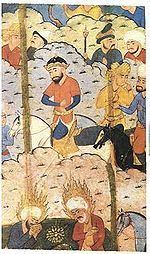 | ||
Books The Maqámát of Badíʻ al-Zamán al Hamadhání, Inventory: Losing, Finding, Collecting Similar Ibn al‑Muqaffa', Al‑Jahiz, Abu Firas al‑Hamdani, Ibn Hisham, Al‑Mutanabbi | ||
Badi' al-Zamān al-Hamadāni or al-Hamadhāni (Arabic: بديع الزمان الهمذاني; 969 CE – 1007 CE) was a medieval Arabo-Persian man of letters born in Hamadan, Iran. He is best known for his work the Maqamat Badi' az-Zaman al-Hamadhani, a collection of 52 episodic stories of a rogue, Abu al-Fath al-Iskandari, as recounted by a narrator, 'Isa b. Hisham. His Arabic name translates into "The Wonder of the Age".
Life
Hamadani was born and educated in Hamedan, Iran. In 990 he went to Gorgan, where he remained two years; then passing to Nishapur, where he rivalled and surpassed the learned Khwarizmi. After journeying through Khorasan and Sistan, he finally settled in Herat under the protection of Abu'l-Hasan Isfaraini, who was the vizier of Mahmud of Ghazni, the sultan of the Ghaznavid dynasty. There he died at the age of forty. He was renowned for a remarkable memory and for fluency of speech, as well as for the purity of his language.
His letters were first published at Constantinople (1881), and with commentary at Beirut (1890); his maqamas at Constantinople, and with commentary at Beirut (1889). A good idea of the latter may be obtained from Silvestre de Sacys edition of six of the maqamas with French translation and notes in his Chrestomathie arabe, vol. iii. (2nd ed., Paris, 1827). A specimen of the letters is translated into German in A. von Kremers Culturgeschichte des Orients, ii. 470 sqq.
